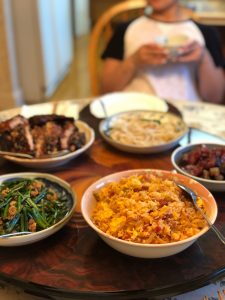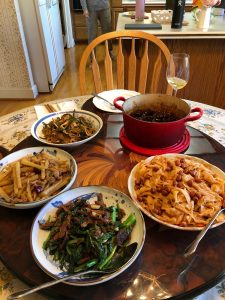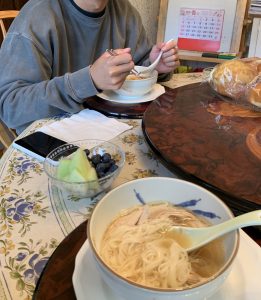My name is Naya Shim, and I am a Korean-American that can speak conversational mandarin, read, and write. On top of the language, I have been really interested in Chinese culture. However, I have never gotten the chance to gain much exposure from my hometown while learning the language. In college, I’ve had incredible opportunities to meet many friends and build relationships with both international and Asian-American students. As a result, I decided to conduct my study about my boyfriend’s table because when I first met the family, I was very nervous about making a good first impression. The last thing I wanted to do was be disrespectful of any of their daily routines, Chinese culture, and most importantly be impolite at the dining table with the wrong etiquette. For this, I had to carefully observe and pick-up on the dining rituals through participant observation and watching the people around me. I also interviewed my boyfriend, Alex, to gain a deeper and more personal perspective because I did not want to rely on my own personal observations where biases could have affected my journal entry!
My first visit entailed a week-long stay in their home, and the parents did not hesitate to make me feel welcome. One of the first things I was asked was if I was hungry and needed to eat. Once I arrived to the house there was a housekeeper living with them to cook and clean, which is very different to what I am used to at home. The nanny was old enough to be my grandmother, and I found it interesting that the mother and nanny would share the role of cooking in the house. This already gave me the impression that food is in fact a shared experience in Chinese culture. The dining table is also a part of an everyday routine. Alex: “Everyone is always kind of running on their own schedule but we always make it back together for dinner.” Dinner was a family meal with an elaborate dining setting for everyone to enjoy and catch up about their day. What supported this the most was the lazy susan in the middle of a table, which I’ve never seen before. My father talks about eating at restaurants with lazy susans during his business trips to China, so I did not expect to see one inside someone’s home-kitchen.

What interests me about my boyfriend’s table the most is the size and shape. I noticed a new flower from the backyard garden every day in the center of the table when it was not used for dining. The table was not really used for anything else other than eating. Observing the lazy susan on this small table made me wonder why it was necessary. When I asked in the interview whether or not there was a significance of the round table, his answer was “round tables are more traditional of Asian households, I think.” This was an interesting answer because my family and extended family have square or rectangular tables. I wondered if it was because my family was too westernized.
Alex’s round table was quaint enough for a family of four to dine there and comfortably reach for the food. However, the lazy susan served a large purpose on the small-midsize dinging table – harmony. Everyone gets the same opportunity to eat the many varieties of food by spinning it around to each family member without interrupting conversation. Alex: “Yeah, if it’s just the four of us it’s four/five dishes and three meats and two veggies. Oh and we also ALWAYS have soup to start with.” In the “Food and Drink Traditions” chapter of the reading, harmony was an ideal that was most present through the flavors, which really aided my understanding of dining with this new family (66). Dinner at the household always started with a soup or broth to warm our stomachs. As pictured, a typical dinner would include a variety of flavors from the sweet barbecue marinated beef ribs, salty vegetables, spicy stir-fry noodles, potatoes, and green spinach.
 There were harmonies amongst other cuisines as well, as lunch and dinner involved more casual meals such as pasta or steak. In fact, Alex even mentioned that “wooden placemats are made in Italy that we got during a family trip” without even knowing the background information about this class! A really interesting observation between the lazy susan and placemats – a mix of western and asian cultures.
There were harmonies amongst other cuisines as well, as lunch and dinner involved more casual meals such as pasta or steak. In fact, Alex even mentioned that “wooden placemats are made in Italy that we got during a family trip” without even knowing the background information about this class! A really interesting observation between the lazy susan and placemats – a mix of western and asian cultures.

Harmonies reflected on temperatures of food as well. Cold food was not served for breakfast and often consisted of noodles. I would wake-up in the morning craving eggs but the chicken broth never disappointed! It actually made me feel great waking up to something warm other than greasy bacon and eggs.
I have never had an authentic home-cooked Chinese/Cantonese meal before, but the food went beyond my expectations. My biases lie in the greasy, oily, unhealthy Chinese-American food that I’ve grown up with when ordering Chinese take-out. Through my own experiences in this house, I was able to overcome these personal biases. The food and medicine reading really helped me understand the medicinal and health connections that played a crucial role in the family’s daily routine.

Every night before bed, everyone was made a cup of hot water brewed with goji berries. My first cup was a bit hard to finish, but it was meant to help digest our dinner and food from the day, boost our metabolism, and warm our stomachs all before going to sleep. I now incorporate this into my daily routine back in Atlanta as well after feeling much better drinking the water (pictured below).

Formal dining does not occur on this dining table, but in a separate dining room with a long rectangular wooden table according to this interview. Perhaps the different shapes and sizes encourage a specific dining experience. I concluded that the small round table enforce an intimate setting where everyone can see and talk comfortably. It is accessible and everyone is an equal. A round table means no one is above another my sitting at the head of the table, yet the father is often served or offered the first take of the food first. Alex says that “no one eats at the table until everyone is seated.” My favorite part of the day during this trip was eating dinner because I felt so welcome into their home sitting elbow-to-elbow with all the family members. In essence, I already felt like a part of the family and not just any random stranger. The lazy susan allows what goes around to come back around. A true shared dining experience. Through sharing and round spaces, the environment provided me a sense of safety and visibility. I felt seen and comfortable, which is why I believe I miss the home-cooked meals the most when thinking about my trip. The food and the way it was able to make me feel has left a long-lasting impression and definitely makes me want to go back again!

Naya, good job on journal#2. You’ve answered the prompt questions fairly well, except for the last question–conclusions about the function and practices associated with the kitchen table. You offered some reflections throughout the essay, but more could be done, especially towards the end. Per the rubric, “connection-making” could be further strengthened; well done on other sections.